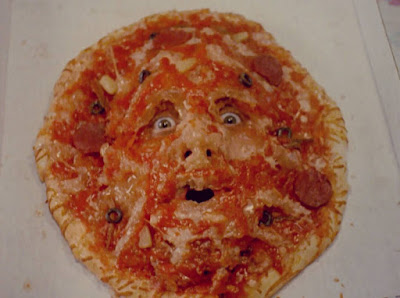Another year, another Halloween
31 for 31 season in which a mania takes over me. Where suddenly the air changes
from summer to autumn, the wind becoming colder and the light starker, and like
lycanthropy for Lon Chaney Jr. I am inflicted
by the desire to write 31 days worth of horror reviews when the tenth month of
the year is even a month away. A season, alongside Halloween, greatly needed
for me as circumstance has left the end of September on a disappointing,
depressed note for my own personal life, a poor moment of timing which
thankfully can thankfully be soothed with family and friendship. It can also be
cured by this crazed ritual of mine,
which forced sadden emotions out in favour of a frenzy that leaves the hands
numb from the constant typing of letters.
In general, my own disappointments
for the end of the summer cannot frankly be compared to how bleak it's been for
many people either. My own concerns of unemployment at the time of writing this
introduction pales in comparison to what's become a terrible year for others in
just these last few months. Even a viewer from afar, through the television or
web screen, looks to what has happened over the last few months natural and
manmade that's caused actual despair and grief for other human beings, and even
the vicarious onlookers feel empathy for them mixed with a melancholy trying to
imagine their positions, let alone those actually affected by any of the series
of newsworthy circumstances which have caused said grief. A season like
Halloween is a necessary one to put one's mind, mine and the readers of this
introduction, at rest.
Admittedly its strange to type
such a thing when Halloween, and horror, is about death and decay. But it's an innate
aspect of horror that its catharsis for the spectators. Its baffling to think
how once moral guardians, not as far back as even the nineteen eighties or
nineties, viewed horror as a corrupting force when you can look back to
literature, even theatre, and find of this gruesome macabre material thriving
and a necessary cure for many emotional ailments. It means the human being can
be a morbid animal, but that's why corpse humour and perversity was invented
too. Halloween as a season was also more spiritually symbolic too, a real
connection to the past and the dead where one spoke to ones' ancestors. So that this doesn't get too serious, I'll
just paraphrase Dan O'Herlihy in Halloween III: Season of the Witch (1982) and
talk of how few people thought further than the strange custom of having your
children wear masks and go out begging for candy. The other advantage is that,
just in terms of horror cinema (and maybe some horror television snuck through
the back door too), for all the weeds that exist in the genre the crops are
also so diverse, the study of horror botany full of numerous wings for the
curious that one shouldn't become bored with the subject if you were a true enthusiast.
Even the weeds are held aloft, as the red paint gore and animal organs are
their own aesthetic choice, and even the most mahogany strong level of wooden
acting gets championed. On the opposite side, that which faces the harshness of
reality will hopefully depict it unflinchingly with far greater power than a
lot of award winning drama.
This year's Halloween 31 For 31 will be weird in how more predictable it is. Less
eclecticism than usual, in terms of nationality and eras of the films, and a
lot of reoccurring motifs. Japanese horror. Franchises. Various coincidences
and connections. A lot of this is to do with this year's marathon being a
eulogy to LoveFilm, a physical
DVD/Blu-Ray rental service that will finally close its doors after fifteen
years of existence on All Hallows Eve, on 31st October 2017. I inherited my
parents' subscription not that long after LoveFilm
came into existence and there's been at least ten years of this postal service
being my guide to cinema since I was a teenager. It's a service which has great
meaning as a method to explore one's aesthetic tastes even if it itself was a
mere luxury now made obsolete. It was where my appreciation for the best of cinema
came from - Wong Kar Wai, Theo
Angelopoulos, Pier Paolo Pasolini,
film movements like the Czeck New Wave and many other discoveries. It was also
from the beginning an access to the strange, psychotropic waters of cult movies
came from, from the films I fell in love with such as Peter Jackson's Braindead
(1992) to films I still need to see after ten years still swirling in my
memories even if my younger self didn't like them. (Such as Flesh for Frankenstein (1973) to The Last House on Dead End Street (1977)).
Inevitably, hopefully, I'll get
into a streaming service like Shudder,
but there's still a tragedy behind all this as, since it was streaming sites
that led to LoveFilm closing their
doors soon, they will undoubtedly still have had a far larger and more useful catalogue
to have viewed than any streaming service for years onwards. Whilst one like Netflix is criticised for barely
scratching the surface of cinema beyond five years ago, LoveFilm purchased rental copies of their discs, including limited
edition sets from the likes of Arrow
Video (why my House series
reviews recently were possible), and for
still retaining all DVDs from the early 2000s onwards if they hadn't been lost
or unavailable. Even if they were pan-and-scan, ripped from VHS and/or ugly as
fuck in modern picture quality standards, it also meant long out-of-print films
you cannot get online for sensible prices were still available to see. If
anything a lot of the odd Japanese horror flicks being covered for this
season's reviews will be a tribute to this aspect of LoveFilm which will sadly be lost, as the discs will vanish and one
is left hoping for either Shudder to
get excptionally obscure in their tastes. Yes, LoveFilm could be a pain in the arse at times. Scratched discs. Discs
not arriving. The attempt to watch every episode of Neon Genesis Evangelion (1995) by post which was compromised by
being over the Christmas holiday and different discs being sent to me instead. But
the service was always worth it, usually reliable and will be missed far more
than a lot of streaming sites of now, as important for me as an actual VHS
rental store was for horror fans growing up in the eighties. The virtues people
talk of nostalgically of VHS rental didn't die away for me personality as the
early DVD boom which led to LoveFilm
meant the exact thing for me in terms of discovering gems and obscurities.
With that in mind, this season
will be meant to be fun. Ignore the strain of everyday drudgery. Unemployment,
autumn colds and various grievances. Ignore the worse in life in general around
the world which is truly awful to witness. Ignore the stupidities of
politicians and leaders of all ideologies left and right who suggest our
species actually devolved from apes rather than evolved. Reveal in horror and
gorge on its multicoloured nature until intoxicated and on the floor babbling. Even
if there's only thirty one slots available, I will be watching films regardless
both to take advantage of LoveFilm
before it gracefully closes its doors and because, even if every day is
Halloween like in the Ministry song,
this is my Christmas. A better holiday than Christmas in fact. Particularly as
there were Christmas trees already out in stores before October has even began,
Halloween is definitely the better holiday just for the fact it doesn't get
shoved down your throat an entire season too early.


























